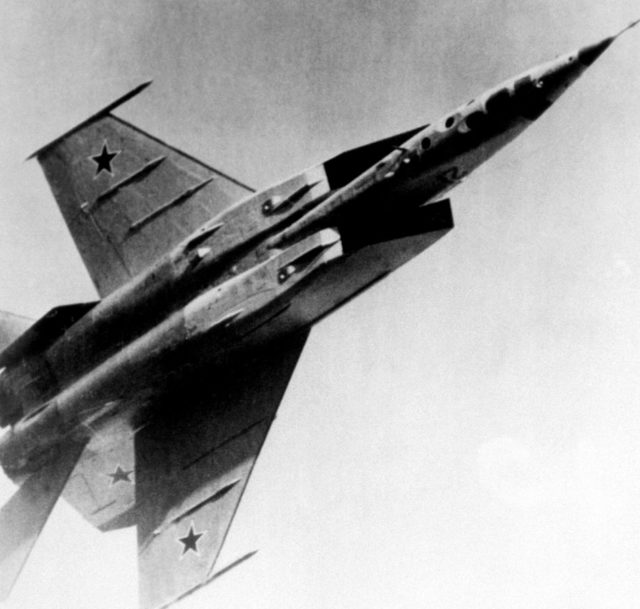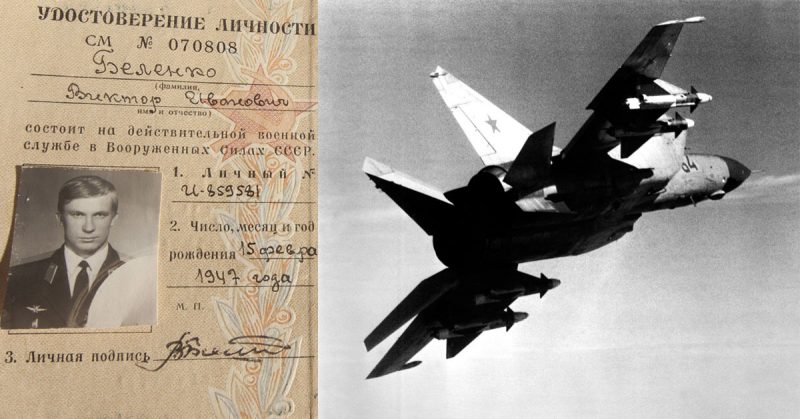On September 6, 1976, a Soviet military jet landed at the airfield in Hakodate, Japan. The runway wasn’t long enough, so the jet actually plowed through hundreds of feet of dirt before coming to rest.
The pilot left the cockpit and fired two warning shots into the air. Motorists on the road next to the airport had gathered and begun taking pictures. After several minutes, airport officials finally reached the aircraft. The pilot, 29-year-old Flight Lieutenant Viktor Ivanovich Belenko of the Soviet Air Defense Forces, said he wanted to defect.
This was not a typical defection. Belenko had just flown 400 miles and landed at a foreign airbase in a Mikoyan-Gurevich MiG-25, the most secretive airplane the Soviets ever developed.
The first time that the Western countries noticed the MiG-25 was around 1970. Spy satellites noticed a new type of aircraft in testing. Western military leaders were particularly concerned about the large wings on the aircraft.
Large wings are helpful in fighter aircraft. They generate lift and make the airplane easier to turn. The new jet seemed to have both large wings and two enormous engines. Military leaders worried about how fast it could go and whether the West had anything that could keep up.
In March of 1971, Israel noticed a new aircraft that accelerated to Mach 3.2 and climbed to 63,000 feet. The Pentagon was faced with the possibility that the Soviets had designed a plane that the US couldn’t keep up with.
It was a classic case of military misinterpretation, says Stephen Trimble, the US editor of Flightglobal. “They seemed to overestimate its abilities on pure appearance,” he says, “from the size of the wing and the huge size of its air intakes.

“They knew it would be very fast and also thought it would be very maneuverable. They were right about the first one, but not about the second one.”
The MiG-25 was built in response to the F-108, SR-71 and B-70 US planes. All had the ability to fly at Mach 2+. The Soviets needed to keep up.
In the 50s, the Soviets did keep up. But the technology required to go from Mach 2 to Mach 3 was a huge challenge that the Soviets needed to meet as soon as possible.
MiG’s Rostislav Belyakov led the design team behind the MiG-25. They used two R-15 turbojets that had been designed for a high-altitude cruise missile. Those engines would require a lot of fuel, so the MiG-25 was built to haul 30,000 pounds of fuel. This made the MiG-25 enormous, only a few feet shorter than a Lancaster bomber.
The Soviets chose to build their new jet from steel. That was the reason for the large wings. They needed to keep all that steel in the air. They did not make the plane more maneuverable like the Pentagon had worried. Also, the fighter version of the plane was only capable of Mach 2.5 due to the weight of its armaments. The reconnaissance version was the one the Israelis had seen do Mach 3.2.
But the Pentagon did not know any of that, and would not unless they could get their hands on one of the planes.
Belenko was the model Soviet citizen. He was born just after WWII near the Caucasus mountains. He joined the military and became a fighter pilot.
He was also facing a divorce. He began to question whether the US was as bad as the USSR propaganda made it out to be.

He worked out a plan. The MiG-25 couldn’t reach a US airbase on a full tank of fuel, but it could reach Japan. One day, on a routine training mission, he broke formation and headed for Japan.
He flew low to avoid radar, both the USSR’s and Japan’s. He was flying his route from memory, intending to land at the Chitose airbase but he only had enough fuel to make it to Hakodate.
The MiG was disassembled and examined, piece by piece. What they learned was that the new Soviet plane was not the “super-fighter” they were afraid of.
“The MiG-25 was not a very useful combat aircraft,” says Connor. “It was an expensive, and cumbersome aircraft, and it wasn’t particularly effective in combat.”
The MiG was a “paper tiger.” Its radar was years behind US models. The enormous engines required massive amounts of fuel, giving the MiG-25 remarkably short range.
